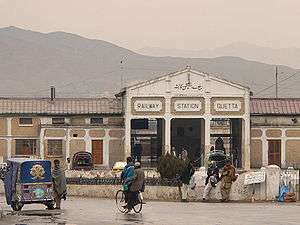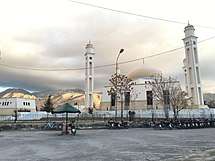Quetta
Quetta
| ||||||
|---|---|---|---|---|---|---|
| Provincial capital | ||||||
Clockwise from top: Jinnah Road, Mount Chiltan, Quetta railway station, a view of Quetta City at night, Bolan Mosque | ||||||
| ||||||
 Quetta  Quetta Location in Pakistan | ||||||
| Coordinates: 30°11′N 67°00′E / 30.183°N 67.000°ECoordinates: 30°11′N 67°00′E / 30.183°N 67.000°E | ||||||
| Country |
Pakistan | |||||
| Region | Balochistan | |||||
| District | Quetta | |||||
| Government | ||||||
| • Type | Municipal Corporation[1] | |||||
| • Mayor of Quetta | Dr Kalimullah Khan [2] | |||||
| • Deputy Mayor of Quetta | Alhaaj Younus Baloch | |||||
| Area | ||||||
| • Total | 2,656 km2 (1,025 sq mi) | |||||
| Elevation | 1,680 m (5,510 ft) | |||||
| Population (2017)[3] | ||||||
| • Total | 1,172,000 | |||||
| • Density | 440/km2 (1,100/sq mi) | |||||
| Quetta Urban agglomeration | ||||||
| Time zone | PKT (UTC+5) | |||||
| Area code(s) | +9281 | |||||
Quetta (Urdu: کوئٹہ, Pashto: کوټه, Hazaragi: کویته Balochi: کویته ![]() pronunciation ) is the provincial capital of Balochistan, Pakistan and the ninth-largest city of the country.[4] The city is known as the fruit garden of Pakistan, due to the numerous fruit orchards in and around it, and the large variety of fruits and dry fruits produced there. [5] The immediate area has long been one of pastures and mountains, with varied plants and animals relative to the dry plains to the west. Quetta was once ruled by the kalats and Kasi and they still own a lot of land over there. Quetta is at an average elevation of 1,680 meters (5,510 feet) above sea level,[6] making it Pakistan's only high-altitude major city. The population of the city is estimated to be approximately 1,172,000.[3]
pronunciation ) is the provincial capital of Balochistan, Pakistan and the ninth-largest city of the country.[4] The city is known as the fruit garden of Pakistan, due to the numerous fruit orchards in and around it, and the large variety of fruits and dry fruits produced there. [5] The immediate area has long been one of pastures and mountains, with varied plants and animals relative to the dry plains to the west. Quetta was once ruled by the kalats and Kasi and they still own a lot of land over there. Quetta is at an average elevation of 1,680 meters (5,510 feet) above sea level,[6] making it Pakistan's only high-altitude major city. The population of the city is estimated to be approximately 1,172,000.[3]
Located in north western Balochistan near the Pakistan-Afghanistan border, Quetta is a trade and communication centre between the two countries. The city lies on the Bolan Pass route which was once the only gateway from Central Asia to South Asia. Quetta played an important role militarily for the Pakistani Armed Forces in the intermittent Afghanistan conflict.
Etymology
'Quetta city is also spelled Kuwatah, which is a variation of Kot, a Pashto word meaning "fortress".[7] It is believed that it relates to the four imposing hills (Chiltan, Takatu, Zarghoon and Murdaar) that surround the city and form a natural bulwark.
British Raj
In 1876 Quetta was incorporated into British controlled territories of the subcontinent. British Troops constructed the infrastructure for their establishment as it was a strategic location. By the time of the earthquake on 31 May 1935 Quetta had developed into a bustling city with a number of multistory buildings and was known as "Little Paris" because of that. The epicenter of the earthquake was close to the city and destroyed most of the city’s infrastructure and killed an estimated 40,000 people.[8]
During the independence movement of Indian subcontinent the predominantly Muslim population of the region supported the Muslim League and the Pakistan Movement.
Geography
Quetta has an area of 2,653 km2 (1,024 sq mi) and consists of series of small river valleys which act as a natural fort surrounded on all sides by hills; these are named Chiltan, Takatoo, Murdar and Zarghun. Although a mostly rocky landscape, there are few natural boundaries between Quetta and its adjoining districts of Dera Ismail Khan to the northeast, Dera Ghazi Khan and Sibi to the east, Sukkur and Jacobabad to the southeast, Karachi and Gawadar to the south and Ziarat to the northeast. The closest city is Kandahar in Afghanistan, north-west at the end of the N25 road. Three main roads gradually fan out to the south, the central route, the N25 leads via the city of Khuzdar to the coastal metropolis of Karachi.


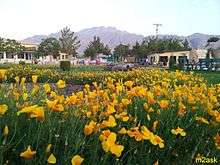
Climate
| Climate data for Quetta, Pakistan | |||||||||||||
|---|---|---|---|---|---|---|---|---|---|---|---|---|---|
| Month | Jan | Feb | Mar | Apr | May | Jun | Jul | Aug | Sep | Oct | Nov | Dec | Year |
| Record high °C (°F) | 23.6 (74.5) |
26.7 (80.1) |
31.1 (88) |
35.0 (95) |
39.4 (102.9) |
41.5 (106.7) |
42.0 (107.6) |
40.6 (105.1) |
38.3 (100.9) |
34.0 (93.2) |
36.0 (96.8) |
25.0 (77) |
42 (107.6) |
| Average high °C (°F) | 10.8 (51.4) |
12.9 (55.2) |
18.7 (65.7) |
24.8 (76.6) |
30.4 (86.7) |
35.3 (95.5) |
35.9 (96.6) |
34.8 (94.6) |
31.4 (88.5) |
25.5 (77.9) |
19.2 (66.6) |
13.3 (55.9) |
24.42 (75.93) |
| Daily mean °C (°F) | 3.7 (38.7) |
6.0 (42.8) |
11.1 (52) |
16.6 (61.9) |
21.0 (69.8) |
25.6 (78.1) |
27.9 (82.2) |
26.4 (79.5) |
21.1 (70) |
14.6 (58.3) |
9.2 (48.6) |
5.1 (41.2) |
15.69 (60.26) |
| Average low °C (°F) | −3.4 (25.9) |
−0.9 (30.4) |
3.4 (38.1) |
8.3 (46.9) |
11.5 (52.7) |
15.9 (60.6) |
19.9 (67.8) |
17.9 (64.2) |
10.9 (51.6) |
3.8 (38.8) |
−0.9 (30.4) |
−3.2 (26.2) |
6.93 (44.47) |
| Record low °C (°F) | −18.3 (−0.9) |
−16.7 (1.9) |
−8.3 (17.1) |
−3.9 (25) |
−0.3 (31.5) |
5.0 (41) |
8.9 (48) |
3.3 (37.9) |
−0.6 (30.9) |
−8.3 (17.1) |
−13.3 (8.1) |
−18.3 (−0.9) |
−18.3 (−0.9) |
| Average precipitation mm (inches) | 56.7 (2.232) |
49 (1.93) |
55 (2.17) |
28.3 (1.114) |
6 (0.24) |
1.1 (0.043) |
12.7 (0.5) |
12.1 (0.476) |
0.3 (0.012) |
3.9 (0.154) |
5.3 (0.209) |
30.5 (1.201) |
260.9 (10.281) |
| Mean monthly sunshine hours | 220.1 | 209.05 | 232.5 | 273 | 334.8 | 327 | 313.1 | 313.1 | 294 | 306.9 | 279 | 238.7 | 3,341.25 |
| Source #1: Hong Kong Observatory (altitude: 1589 m)[9] | |||||||||||||
| Source #2: PMD[10] | |||||||||||||
Quetta has a high semi-arid climate (Köppen BSk) with a significant variation between summer and winter temperatures. Summer starts about late May and goes on until early September with average temperatures ranging from 24–26 °C (75–79 °F). The highest temperature in Quetta is 42 °C (108 °F) which was recorded on 10 July 1998.[11] Autumn starts in late September and continues until mid-November with average temperatures in the 12–18 °C (54–64 °F) range. Winter starts in late November and ends in late March, with average temperatures near 4–5 °C (39–41 °F). The lowest temperature in Quetta is −18.3 °C (−0.9 °F) which was recorded on 8 January 1970.[11] Spring starts in early April and ends in late May, with average temperatures close to 15 °C (59 °F). Unlike more easterly parts of Pakistan, Quetta does not have a monsoon season of heavy rainfall. Highest rainfall during 24 hours in Quetta is 113 millimetres (4.4 in) which was recorded on 17 December 2000,[11] Highest monthly rainfall is 232.4 millimetres (9.15 in) which was recorded in March, 1982, also the year of the highest annual rainfall, at 949.8 millimetres (37.39 in).[11] In the winter, snowfall has become quite erratic (December, January and February).
The city saw a severe drought from 1999 to 2001, during which the city did not receive snowfall and below normal rains. In 2003 the city received snowfall after a hiatus of five years. In 2004, and 2005 the city received normal rains after three years without snowfall while in 2006, 2007 and 2009 the city received no snow except in 2008 when Quetta received a snowfall of 10 centimetres (4 in) in four hours on 29 January 2008.[12] On 2 February it further received 25.4 centimetres (10 in) in 10 hours[13] which was the heaviest snowfall for the city in the last ten years. During the winter of 2010 it received no snow and saw below normal rains due to the presence of El-Nino over Pakistan.[11]
Government and politics
At the local government level, the city is governed by a municipal corporation consisting of 66 ward members which elects a mayor and a deputy mayor.[1]
Transport
.jpg)
Quetta is on the western side of Pakistan and is connected to the rest of the country by a network of roads, railways and its international airport close to its center.
At an altitude of 1,605 metres (5,266 feet) above sea level, Quetta Airport is the second highest airport in Pakistan.[14] Pakistan International Airlines has regular flights to and from the other major cities of Pakistan including Islamabad, Gwadar, Karachi, Lahore and Peshawar.
Quetta Railway Station is one of the highest railway stations in Pakistan at 1,676 metres (5,499 feet) above sea level. The railway track was laid in the 1890s during the British era to link Quetta with rest of the country. The extensive network of Pakistan Railways connects Quetta to Karachi in the south, by a 863 km (536 mi) track, Lahore in the northeast (1,170 km or 727 miles) and Peshawar further northeast (1,587 km or 986 miles). A metalled road runs alongside the railway that connects Quetta to Karachi via the nearby town of Sibi to Jacobabad and Rohri in the plain of the River Indus.
A track from the Iranian city of Zahedan links to Quetta via Taftan, Balochistan. Service was temporarily discontinued in 2006 due to unrest in Balochistan. Since 2008 railway service has come under attack by the Balochs, especially in the Bolan Pass area resulting in a bomb blast on the railway tracks and firing on trains.
There has been a proposal to construct a railway track that will link Gawadar to China and Gawadar with Quetta via Kalat. Although the distance from Quetta to Lahore is only 700 km (430 mi), there is no direct track on this route because of the Sulaiman Range that lies in the east of Quetta. All northeast-bound trains for Punjab or Khyber Pakhtunkhwa must first go over 350 km (220 mi) south to Rohri, Sindh (near Sukkur) before continuing north to Punjab and Khyber Pakhtunkhwa.
Quetta is connected by metalled roads to the rest of the country. A road connects it with Karachi through Mastung, Kalat, Khuzdar and Lasbela. Other major roads are Quetta to Karachi following the Sibi, Jacobabad, Sukkur and Hyderabad route and two roads from Quetta to Lahore one (the older) via Sibi, Sukkur, Rahim Yar Khan, Bahawalpur and Multan the other route via Khanozai, Muslimbagh Loralai, Fort Mondro, Dera Ghazi Khan and Multan. Quetta is connected with Afghanistan through Chaman and to Iran through Mastung, Nushki, Dalbandin and Taftan.
Flora and fauna
Mammals such as Markhor (wild sheep), leopards, wolves, hyena, rabbits, wild cats and porcupines are to be found in the Quetta region. Local birds species include partridge, warblers, shikra, the blue rock pigeon, rock nuthatch, golden eagle, sparrows, hawks, falcons and bearded vultures. A total of 225 species of flora have been identified in the area including pistachios, juniper, wild olives, wild ash and wild almonds. Also found are shrubs including wild fig, barberry, wild cherry, makhi and herbs such as ephedra intermadia and gerardiana.
Attractions

Hanna Lake, which nestles in the hills ten kilometres (six miles) east of the city, is a turquoise body of water that contrasts markedly with the bare surrounding hills. It is an attractive destination for vacationers, with facilities for boat hire. A lakeside restaurant is crowded with hikers and campers during holiday periods. At one end there is an irrigation dam, while on the eastern shore there is Hayat Durrani Water Sports Academy, the only water sports training center in Balochistan. The Hanna Lake Development Authority, the Hayat Durrani Water Sports Academy and Merck Marker have planted a range of trees in the Hanna Lake Mountains both for beautification and the protection of the environment.[15] [16]
The Hazarganji Chiltan National Park, 20 km (12 mi) south-west of Quetta, Markhors is a protected park area. The name of the park, "Hazarganji" literally means "Of a thousand treasures" is spread over 32,500 acres (132 km2) at an altitude ranging from 2,021 to 3,264 metres (6,631 to 10,709 ft). In the folds of the mountains, according to legend, there are over a thousand buried treasures, reminders of the passage over the ages of great armies including the Bactrians, the Scythians, the Muslims, and the Mongols. Pir Ghaib is a waterfall and picnic spot located 70 km from the Quetta City in historic Bolan valley. Kharkhasa is located 10 km (6.2 mi) west of Quetta in a 16 km (9.9 mi) long narrow valley that contains a variety of flora and fauna species. The Chiltan Hill Viewpoint in the park provides a panoramic view of the city. A visit to the nearby cities of Kirani and Ziarat are popular scenic places for tourists travelling to and from Quetta. The Quetta Geological Museum, located on Sariab Road has a collection of rocks and fossils found in Balochistan. The Command and Staff College Museum is a museum dedicated to British military history. It is housed in the former bungalow of Field Marshal Bernard Montgomery. The Quetta Archaeological Museum, located on Fifa Road has a collection of rare antique guns, swords, manuscripts and a display of Stone Age tools, prehistoric pottery and articles found in Mehrgarh. There are also coins, manuscripts and photos of Quetta before the 1935 earthquake.
The Balochistan Arts Council Library houses arts and crafts from the province.
Name of Manan Chowk Quetta was given for the name Manan Barrech who was killed by Police during protest on the day of Khan Abdul Samad Khan Shaeed on 2 December 1973.
Shah Jahan Chowk in Quetta was called Junction Chowk, named after Shah Jahan Kassi, who died whilst fighting against Khunkhwar Khirrel (Ramazan Khirrle's Brother).
Educational institutions
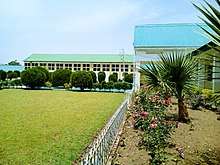
Quetta serves as the learning center for the Balochistan province. The city has a number of government and private colleges, including the following:
- University of Balochistan
- Balochistan University of Information Technology, Engineering and Management Sciences (BUITEMS)
- Sardar Bahadur Khan Women's University
- Islamia High School: It was frequently visited by Quaid-e-Azam in 1937 and was nicknamed as Chhota Aligarh (Little Aligarh) by him[17]
- Bolan Medical College
- Balochistan Agriculture College
- Geological Survey of Pakistan
- Federal Government (FG) Degree College
- Tameer-e-Nau Public College
- St. Francis Grammar School since 1946
- Command and Staff College
- Quetta Results
The Balochistan Board Quetta is an Intermediate and Secondary education board for Balochistan. It conducts Secondary School and Higher Secondary School examination throughout the province.
Demographics

The population of the city is around one million. In 2016, it was estimated at 1,140,000.[3] This makes it the largest city in Balochistan province and one of the major cities of Pakistan. The scholars disagree about the demographics of the city. According to some, the city has a Pashtun plurality followed by Baloch / Brahui, other indigenous people of Balochistan and lastly the settlers from other areas of Pakistan.[18] Others think, the city has a Pashtun majority followed by Brahui, Baloch, Punjabis, Muhajir people and Hazaras.[19] [20][21]Urdu being national language is used and understood by all the residents and serves as lingua franca. Languages spoken as first language include Pashto, Punjabi, Balochi and others.[18]
| Rank | Language | 1998 census[18] |
|---|---|---|
| 1 | Balochi | 25% |
| 2 | Pashto | 23.7% |
| 3 | Punjabi | 21.7% |
| 4 | Others | 29.6% |
Festivals and shopping
Cultural and religious festivals are held in the city every year. The two Eid festivals which mark the end of fasting and the end of the Hajj allow the majority Muslim community to put on musical shows, distribute sweets and presents. Buzkashi is a festival celebrated by Pashtuns in which two teams on horse-back attempt to snatch a goat from each other.
Quetta's bazaars are the Shahrah-e-Liaquat (Liaquat Bazaar and Suraj Gang Bazaar), the Shahrah-e-Iqbal (Kandahari Bazaar) and Jinnah Road. Colorful handicrafts are sold, particularly Balochi mirror work and Pashtun embroidery. Afghan rugs, fur coats, embroidered jackets, waistcoats, sandals, and other traditional Pashtun items are also sold.
Pashtun rugs and Balochi carpets are made by the nomadic tribes of the area. They are generally not as fine or as expensive as either the Persian products or the Turkoman tribal rugs but they are generally more authentic and unique than copies of Turkoman and Persian designs.
Cuisine
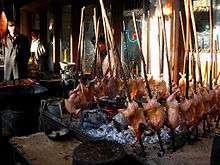
The traditional dishes such as Kadi kebab and Lamb Roast and Saji and other traditional dishes are available around the city especially at Prince Road, Jinnah Road, Serena Hotels. The Pashtun tribal cuisine "Roast", which non-locals call "Namkin", is served in city restaurants as well as in the outlying areas. Some of the finest mutton in the country is raised around Quetta and is a mainstay of local cuisine. The Pashtun tribal dish, "Landhi", is made of a whole lamb which is dried and kept fresh during the cold winter. "Khadi Kebab" is a lamb barbecue while "Sajji" (leg of lamb) and "Pulao" are other local dishes. Bolani, a traditional snack food which is baked or fried with a vegetable filling. It has a thin crust and can be stuffed with a variety of ingredients, such as potatoes, lentils, pumpkin, chives, or leeks. Restaurants include Usmania, Tabaq, Green Hotel, Gulab Hotel, Lal Kabab, and the Abasin Hotel all of which serve both Pakistani and western food while the Café China is one of the oldest Chinese restaurants.
Sports
Cricket and football are the two most popular sports among the people of Quetta. However, a number of other sports are also played. This includes, hockey, taekwondo, boxing, squash, mountaineering, and bodybuilding.

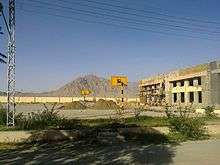
Football teams from Quetta include Quetta Zorawar, Muslim FC, Hazara Green Football, Baluch Football and Quetta Bazigars Club. The Shaheed Nauoroz Stadium is the largest stadium in the city. The city also has Ayub National Stadium, a multipurpose stadium used for football and cricket and Bugti Stadium used only for cricket.
The Quetta Bears are a domestic cricket team represented the city in the List A and Twenty 20 tournaments.
Quetta Gladiators (Urdu: کوئٹہ گلیڈئیٹرز) is a Pakistani professional Twenty20 cricket team that competes in Pakistan Super League (PSL).
In hockey, Quetta has produced Zeeshan Ashraf and Shakeel Abbasi, who are members of the Pakistan national hockey team.
In bodybuilding, Din Mohammad Brohi (Mr. Pakistan title), Noorullah Khan Durrani and Nisar Ahmed Khilji (Mr. Pakistan title for Senior and Junior) have come from Quetta. In boxing Olympians from Quetta include: Shaheed Abrar Hussain Hazara killed by LeJ, Abdul Salam Khan Kakar, Asghar Ali Changezi and Haider Ali Changezi. Competitive weight lifting has seen Olympic level success. Local such athletes include Dilawar Khan Khilji, Mohammad Rafiq Khan Khilji and Mohammad Alam Khan Kakar.
In squash, Hiddy Jahan Khan was ranked among the top six players in the world from 1970 through to 1986. British Open champion Qamar Zaman also hails from Quetta. Other notable local squash players include: Zarak Jahan Khan, Abdul Hadi Kakar, Waheed Barech, Abdul Wali Khan Khilji, Hamayoon Khan Khilji, Zubair Jahan Khan, Shams ul Islam Khan Kakar, Tariq Rahim Khan Kakar, and Shaied Zaman Khan.
Facilities
Local facilities were created in the city for mountain climbing and caving as well as water sports. Hayatullah Khan Durrani (Pride of Performance) is the chief executive of Hayat Durrani Water Sports Academy at Hanna Lake. In kayaking, Muhammad Abubakar Durrani, National Junior Champion was selected for the world Junior Canoeing Championship in 2009 in Moscow.[22][23]
See also
- 1935 Quetta earthquake
- 2008 Ziarat earthquake
- History of Quetta
- List of people from Quetta
- Pashtun cuisine
Gallery
- Snow-covered hill, near Hanna Urak
- China Chowk, at the starting end of Jinnah Road
References
- 1 2 "Government Organization - Government of Balochistan". balochistan.gov.pk. Retrieved 6 September 2016.
- ↑ "PkMAP candidate nominated for Quetta mayor".
- 1 2 3 http://www.demographia.com/db-worldua.pdf
- ↑ http://www.pbs.gov.pk/sites/default/files//tables/POPULATION%20SIZE%20AND%20GROWTH%20OF%20MAJOR%20CITIES.pdf
- ↑ "The Fruit Garden of Pakistan - Quetta". asadasif.com. 4 February 2008. Retrieved 10 January 2017.
- ↑ "Mongabay -environmental science and conservation news".
- ↑ ""History of Quetta" Government of Quetta". quetta.gov.pk. Archived from the original on 9 March 2011. Retrieved 26 June 2016.
- ↑ ڈان اردو. "پاکستانی شہروں کی تاریخ". dawnnews.tv. Retrieved 26 February 2016.
- ↑ "Climatological Normals of Quetta". Hong Kong Observatory. Retrieved 2014-01-27.
- ↑ "Extremes of Quetta". Pakistan Meteorological Department. Retrieved February 3, 2015.
- 1 2 3 4 5 Archived 13 June 2010 at the Wayback Machine.
- ↑ Archived 4 January 2009 at the Wayback Machine.
- ↑ "Leading News Resource of Pakistan". Daily Times. 4 February 2008. Retrieved 8 May 2012.
- ↑ Quetta Airport Archived 29 June 2009 at the Wayback Machine. CAA Pakistan, Accessed 24 June 2009
- ↑ Dawn News Daily|http://www.dawn.com/news/1096332.
- ↑ Pakistan Times|http://news.pakistantimes.com/2014/08/15/abubakar-durrani-wins-independence-day-canoeing-championship-2014-320236.
- ↑ Dr. Javed Haider Sayed (2008). "The Balochistan Muslim League" (PDF). National Institute of Historical & Cultural Research - Pakistan. Quaid-e-Azam University, Islamabad. Retrieved 6 March 2016.
- 1 2 3 Jonah Blank, Christopher Clary & Brian Nichiporuk 2014.
- ↑ "Pakistan and the Karakoram Highway by Sarina Singh — Pashtun Make The Majority".
- ↑ "The Crowded-Out Conflict by Ann Wilkens — Pashtun form the Majority".
- ↑ "The Pashtun Question by Abubakar Siddique — Quetta has a Pashtun Majority".
- ↑ Pakistan Players for Moscow Archived 24 January 2013 at Archive.is
- ↑ "GEO TV Report Pakistan Players for Moscow >". Geo.tv. 28 July 2009. Archived from the original on 25 December 2014. Retrieved 21 January 2014.
Bibliography
- Jonah Blank; Christopher Clary; Brian Nichiporuk (30 October 2014), Drivers of Long-Term Insecurity and Instability in Pakistan: Urbanization, Rand Corporation, p. 29, ISBN 978-0-83-308751-5

